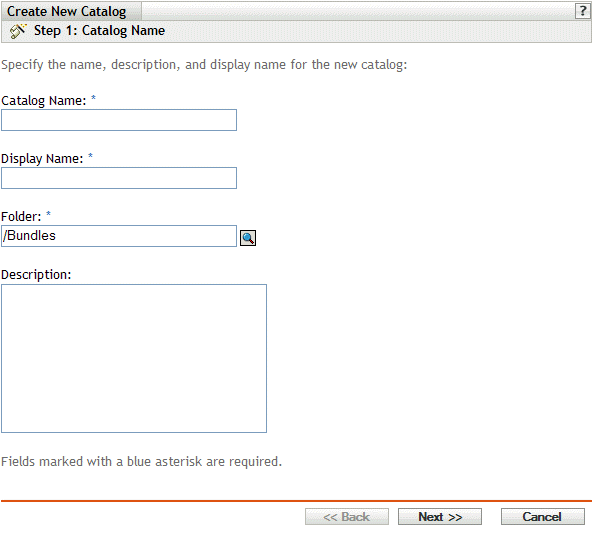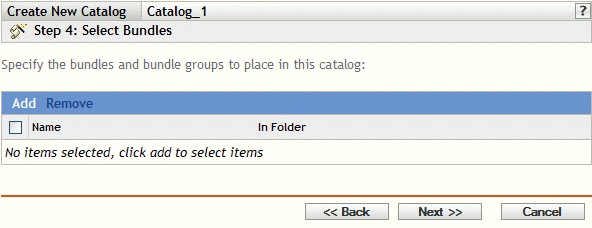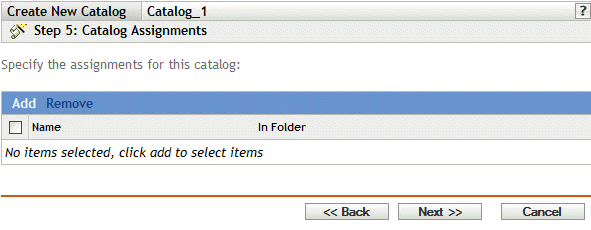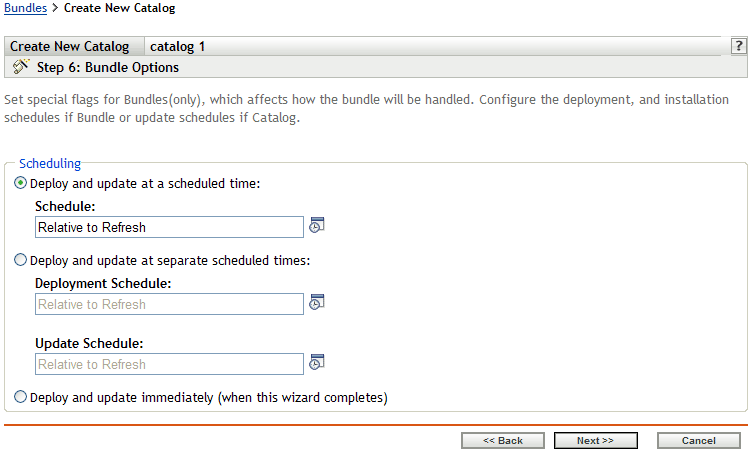22.2 Creating Catalogs
You can use the ZENworks Control Center or the zlman command line utility to create catalogs. The following procedure explains how to perform this task using the ZENworks Control Center. If you prefer the zlman command line utility, see the Catalog Commands section of zlman (1).
-
In the ZENworks Control Center, click the tab.
-
In the list, click , then click to display the Catalog Name page.

-
Fill in the fields:
-
Catalog name: (Required) Provide a unique name for your catalog. The name you provide displays in the ZENworks Control Center interface, which is the administrative tool for ZENworks Linux Management.
For more information, see Section C.0, Naming Conventions in the ZENworks Control Center.
-
Display name: (Required) Provide a name that displays for users when they install, update, or remove software. The display name can be the same name that you provided in the box; however, you can choose to make the name more intuitive for users. In the next step in this wizard, Catalog Attributes, you can specify to hide this catalog from users.
-
Folder: (Required) Type or browse to the folder that contains this catalog in the ZENworks Control Center interface.
-
Description: Provide a short description of the catalog's contents. This description displays in the ZENworks Control Center interface and in the user interface. In the next step in this wizard, Catalog Attributes, you can specify to hide this catalog in the user interface.
-
-
Click to display the Catalog Attributes page.

-
(Optional) Select the option to hide the catalog from users; the catalog displays in the ZENworks Control Center interface, which is the administrative tool for ZENworks Linux Management, but is hidden from users.
This option is useful if you have a bundle or catalog containing a primary package that has dependent packages that must already be installed on devices. You can hide the catalog containing these dependent packages from users. When the primary package in a bundle or catalog is deployed and installed, all dependent packages in the hidden catalog are also deployed and installed.
For example, suppose you have an anti-virus application that you want to deploy and install using a catalog. You could make this catalog visible to users. Suppose that you also need to install updated definition files on devices before the primary package in the bundle or catalog can be installed. You could hide the catalog containing the definition files from users. When the primary package in the bundle or in the visible catalog is deployed and installed, the dependent packages in the hidden catalog are also deployed and installed.
IMPORTANT:If you hide an optional catalog (none of the packages contains dependent packages) from the user interface, the catalog is never deployed and installed. For this reason, you should only hide catalogs that contain dependent packages. When the primary package contained in a bundle or catalog is deployed and installed, the dependent packages contained in the hidden catalog are also deployed and installed.
-
Click to display the Summary page, then review the information on the Summary page, making any changes to the bundle settings by using the button as necessary.
Depending on your needs, you can create the catalog now or you can configure additional settings for this catalog.
-
Click to create the Catalog as configured per settings on the Summary page. If you click , the catalog is created but it does not contain bundles, have any assignments, a schedule, and so forth. At some time in the future, you need to perform the steps under Section 22.3, Assigning Catalogs.
or
Click to display the Select Bundles page to perform the following tasks:
-
Specify bundles and bundle groups to place in this catalog
-
Specify the assignments for this catalog
-
Specify special flags, such as flags to specify to remove conflicting packages or trying a dry run to test a bundle's deployment
-
Specify the update and deployment schedules for this bundle

-
-
Specify bundles and bundle groups for this catalog.
-
Click to display the Select Bundles dialog box, then browse for and select the bundles and bundle groups you want to assign to this catalog.
Click the underlined link in the column to select the bundles or bundle groups and to display their names in the list box.
-
Click .
-
-
Click to display the Catalog Assignments page.

-
Assign this catalog to the devices that you want to distribute the catalog to.
-
Click to display the Select Assignments dialog box.
-
Click the blue arrow next to or to expand the list, then click the underlined link in the column to select the desired objects and display their names in the list box.
You can also select Folder or Group objects.
Assigning a catalog to a Folder or Group object is the preferred method of associating the catalog. Assigning the catalog to a large number of objects (for example, more than 250) might cause increased server utilization.
-
Click .
-
-
Click to display the Bundles Options page.

-
(Optional) Specify the desired Special Flag options:
-
Remove conflicting packages: Select this option to specify that conflicting packages and files are uninstalled from devices before installing new packages and files. By default, this option is selected, so conflicting packages and files (previous versions of the same package, for example) are uninstalled before the current package or file is installed. If this option is not selected, packages and files are not installed if a conflict is detected.
-
Attempt a dry run: Select this option to have ZENworks Linux Management perform a test to determine if the RPM bundle or files can be successfully deployed. If there are any issues that could prevent the RPM bundle or file bundle from being deployed, you can look at the log file to troubleshoot the bundle-creation process. The log file is located in /var/opt/novell/logs/zenworks.
A successful dry run ensures that the bundle can be successfully deployed or installed on assigned devices (packages are available, dependencies are met, etc.).
-
-
Specify the desired Scheduling options:
-
Deploy and update at a scheduled time: Use this option to schedule the deployment and installation of the bundles contained in this bundle group. Click the icon to choose the schedule type.
The following schedules are available. Click the link in the left column in the table below for more information about each schedule type and its options.
-
Deploy and update at separate scheduled times: Use this option to specify an optional deployment schedule separate from the installation schedule. If you select this option, you can set up a deployment schedule and an installation schedule. If you do not select this option, the packages will be deployed and installed on assigned devices according to the schedule. Click the icon to choose the schedule type.
The following schedules are available. Click the link in the left column in the table below for more information about each schedule type and its options.
The option is not set by default. In most situations, there is no need to deploy and install packages inside bundles at different times. You can, depending on your needs, schedule deployment and installation at different times to conserve network bandwidth or to perform the actions at more convenient times for users.
The deployment schedule determines when the packages and files inside the bundle are downloaded from the server to the assigned devices. The packages and files are not yet installed and available for use. The installation schedule determines when the packages and files are installed on assigned devices so the packages will be available for use.
-
Deploy and update immediately (when this wizard completes): Select this option to specify that the packages inside the bundle group deploy and install immediately when the Create New Group Wizard completes, providing that the assigned devices are online. The packages inside the bundle group deploy to and install on devices that are not online when they refresh.
-
-
Click to display the Finish page, review the information on the Finish page, make any changes to the settings by using the button as necessary, then click to create the item as configured per settings on the Finish page.
-
Click .